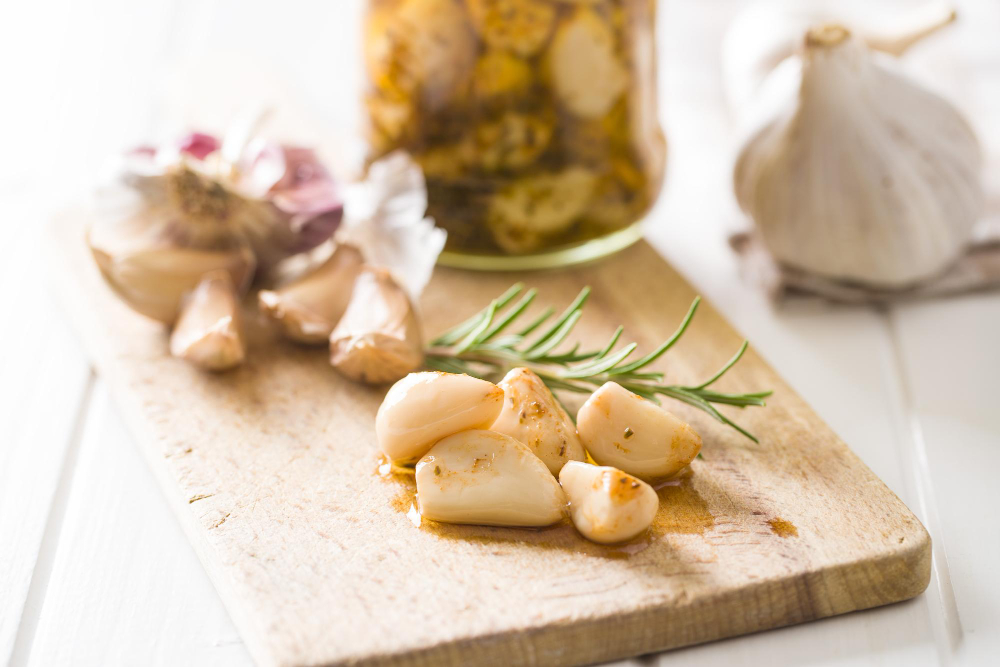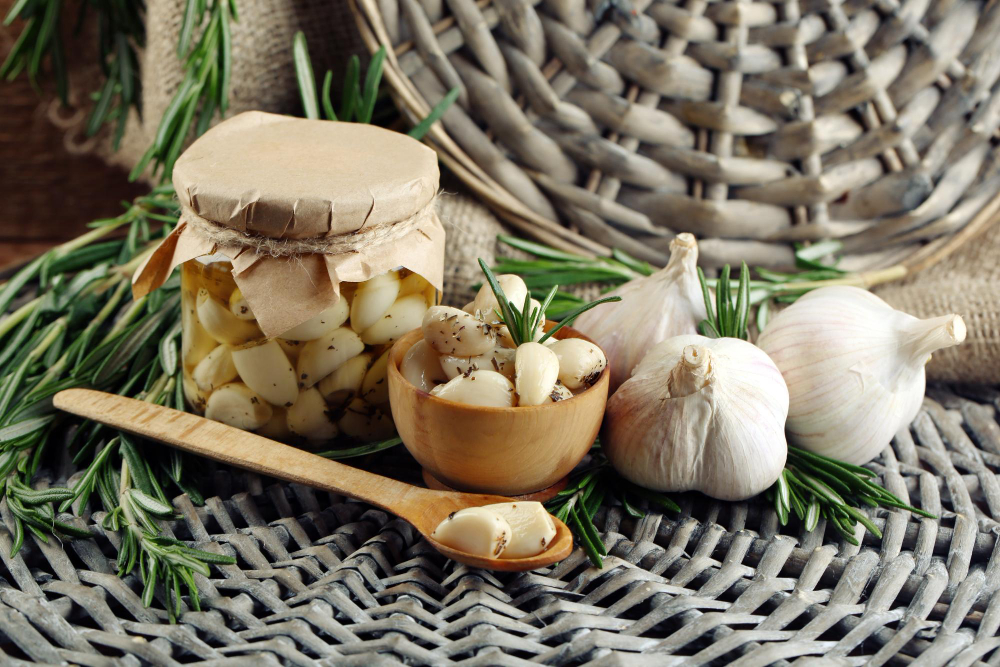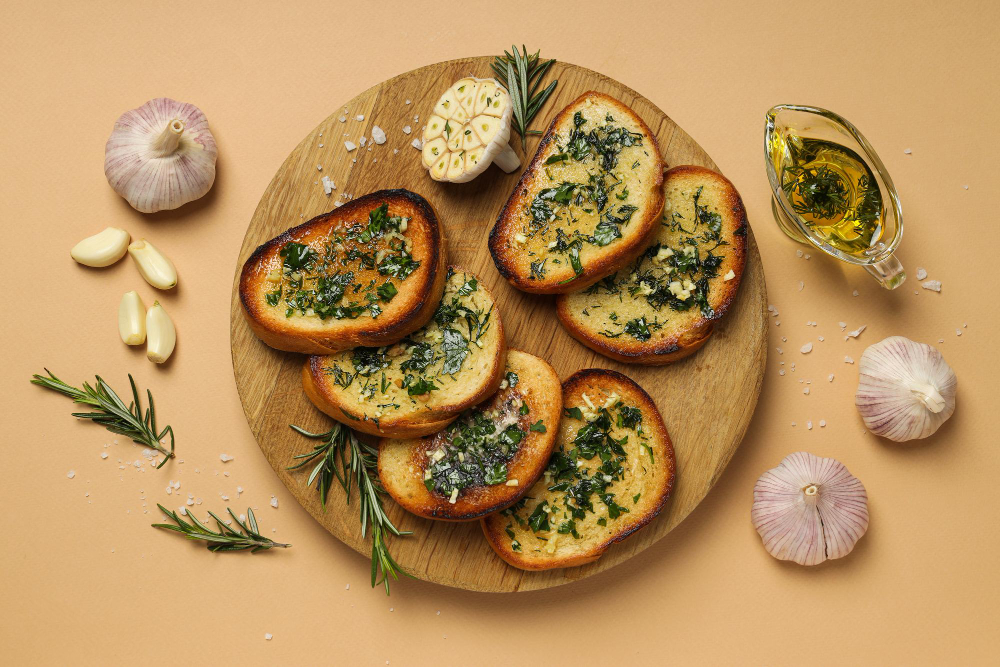Garlic confit is a culinary gem that transforms ordinary garlic into a rich, flavorful delicacy. Garlic confit involves gently cooking garlic cloves in olive oil until they become tender and sweet.
The process is simple yet yields impressive results. Peeled garlic cloves are slowly cooked in oil at a low temperature, often with herbs like thyme added for extra flavor. This method softens the garlic's sharp bite and brings out its natural sweetness. The resulting cloves are soft, spreadable, and packed with mellow garlic flavor.
Garlic confit can be used in many ways. It's great spread on toast, mixed into mashed potatoes, or added to pasta dishes. The oil used for cooking becomes infused with garlic flavor and can be used in salad dressings or for sautéing vegetables. Making garlic confit at home is easy and allows cooks to create a versatile ingredient that adds depth to many dishes.
Understanding Garlic Confit
Garlic confit is a culinary technique that transforms raw garlic into a soft, flavorful ingredient. This method has roots in French cooking and offers a unique way to enjoy garlic's taste.
Definition and Origins
Garlic confit is made by slowly cooking peeled garlic cloves in oil. The word "confit" comes from the French verb "confire," which means to preserve. This cooking method originated as a way to preserve foods before refrigeration.
In French cuisine, confit often refers to meat cooked in its own fat. But the technique works well for garlic, too. The slow cooking process makes the garlic cloves soft and sweet.
Chefs prize garlic confit for its mild, nutty flavor. It's less sharp than raw garlic. The oil used in cooking also takes on a garlicky taste.
Comparing Garlic Confit to Roasted Garlic
Garlic confit differs from roasted garlic in a few key ways:
- Cooking method: Confit uses oil, roasted garlic uses dry heat
- Texture: Confit is softer and oilier
- Flavor: Confit is milder and sweeter
Roasted garlic often has a deeper, more caramelized taste. Garlic confit keeps more of its original flavor, just softened.
Both methods make garlic easier to spread. They also reduce garlic's sharp bite. But confit results in a more buttery texture.
Health and Safety Considerations
Garlic confit can be a tasty addition to many dishes. But it requires careful handling to stay safe. The low-oxygen environment can allow harmful bacteria to grow if not stored properly.
To reduce risks:
- Store garlic confit in the fridge
- Use clean utensils when handling
- Consume within 2-4 weeks
Botulism is a rare but serious risk with improperly stored garlic in oil. Always follow food safety guidelines when making and storing garlic confit.
On the plus side, garlic has many health benefits. It may help lower blood pressure and boost the immune system. The cooking process in confit preserves many of these benefits.
Preparing Your Ingredients

Getting ready to make garlic confit starts with choosing the right ingredients. The quality of your garlic and oil will greatly impact the final product.
Selecting Quality Garlic
Look for firm, plump garlic bulbs with tight, dry skins. Avoid any with soft spots or signs of sprouting. Fresh garlic cloves should be creamy white or light purple.
Peel the cloves carefully to keep them whole. A gentle crush with the flat side of a knife can help loosen the skins. Peeled garlic cloves are the main star of garlic confit, so take your time with this step.
For best results, use about 2-3 heads of garlic. This will yield enough confit for several uses while ensuring the cloves are fully covered in oil during cooking.
Choosing the Right Type of Oil
Extra-virgin olive oil is the top choice for garlic confit. Its rich flavor complements the garlic well. Choose a high-quality oil with a mild, fruity taste.
Neutral oils like grapeseed or canola can also work. These are good options if you want a more subtle flavor that lets the garlic shine.
Make sure to have enough oil to fully cover the garlic cloves. This usually means about 1-2 cups, depending on the size of your cooking vessel.
Herbs and Spices for Flavor
Adding herbs and spices can elevate your garlic confit. Fresh herbs like thyme and rosemary work well. They infuse the oil with extra flavor.
Dried bay leaves and whole peppercorns are classic additions. They add depth without overpowering the garlic.
For a bit of heat, try adding crushed red pepper flakes or a dried red chile. Start with a small amount - you can always add more later.
Here's a quick list of popular additions:
• Fresh thyme sprigs
• Fresh rosemary sprigs
• 1-2 bay leaves
• 5-6 whole black peppercorns
• 1/4 teaspoon red pepper flakes
Mix and match these to create your own unique flavor profile.
Cooking Techniques
Garlic confit can be prepared using different methods. Each technique results in tender, flavorful garlic cloves that can enhance many dishes.
Oven Method for Garlic Confit
The oven method is simple and hands-off. Preheat your oven to 250°F (120°C). Place peeled garlic cloves in a baking dish and cover them with olive oil. The oil should completely submerge the cloves.
Bake for about 2 hours or until the garlic turns golden and soft. Check occasionally to ensure the garlic isn't browning too quickly. If it is, lower the temperature slightly.
Once done, let the garlic cool in the oil. This method allows for even cooking and produces consistently tender cloves.
Stovetop Method
The stovetop method offers more control over the cooking process. Place peeled garlic cloves in a saucepan and cover with olive oil. Heat the oil over low heat until it begins to simmer gently.
Cook for about 45 minutes, maintaining a low simmer. The garlic is ready when it's golden and easily pierced with a fork. Be careful not to let the oil get too hot, as this can cause the garlic to burn.
Remove from heat and let cool in the oil. This method is quicker than the oven method but requires more attention.
Storing and Preserving Confit
Proper storage is crucial for garlic confit. Once cooled, transfer the garlic and oil to a clean, sterilized jar. Make sure the garlic is completely covered by oil to prevent spoilage.
Refrigerate the confit immediately. When stored properly in an airtight container, garlic confit can last up to two weeks in the refrigerator.
Never store garlic confit at room temperature, as this can lead to botulism. Always use clean utensils when removing garlic from the jar to avoid contamination.
Culinary Uses

Garlic confit offers versatile applications in cooking. Its mellow, sweet flavor enhances many dishes and creates delicious infusions.
Enhancing Dishes
Garlic confit adds depth to various recipes. Chefs use it in mashed potatoes for extra richness. The soft cloves blend smoothly, imparting a subtle garlic taste.
In pasta dishes, confit garlic creates a flavorful base. Cooks can mash the cloves into sauces or toss them whole with noodles.
Soups benefit from garlic confit's smooth texture. It melts into broths, adding complexity without overpowering other ingredients.
Roasted vegetables pair well with garlic confit. Chefs drizzle the infused oil over root vegetables before roasting for added flavor.
Creating Infused Oils and Dressings
The oil from garlic confit serves as a flavor-packed base for dressings. It adds a mellow garlic taste to vinaigrettes and salad dressings.
Cooks use the infused oil in marinades for meats and vegetables. Its subtle flavor permeates foods during cooking.
Garlic-infused oil works well for sautéing. It imparts a gentle garlic flavor to stir-fries and other quick-cooked dishes.
Drizzling the oil over finished dishes adds a final touch of flavor. It's especially good on grilled meats or roasted vegetables.
Homemade Garlic Butter and Spreads
Garlic confit makes excellent spreads. The soft cloves mash easily into butter, creating a delicious compound butter.
Chefs spread garlic confit directly on bread or crackers. Its smooth texture and mild flavor make it an ideal appetizer.
Mixing garlic confit into mayonnaise creates a tasty aioli. This spread works well on sandwiches or as a dip for vegetables.
Hummus gains depth from added garlic confit. The cloves blend smoothly, enhancing the dip's flavor without overpowering it.
Creative Serving Suggestions

Garlic confit offers a sweet, mellow flavor that enhances many dishes. This versatile ingredient can be used in various ways to add depth and richness to meals.
Pairing with Bread and Crackers
Garlic confit makes an excellent spread for crusty bread or crackers. Its soft, spreadable texture allows it to be easily smeared on toasted baguette slices or artisanal bread.
For a quick appetizer, top crostini with garlic confit and a slice of fresh mozzarella. The combination creates a delightful balance of flavors.
Another option is to mix mashed garlic confit with softened butter to create a flavorful compound butter. This can be spread on warm dinner rolls or used to make garlic bread.
Incorporation into Main Courses
Garlic confit can elevate many main dishes. It pairs well with pasta, adding a subtle garlic flavor without overpowering the dish.
To make a simple pasta sauce, blend garlic confit with olive oil and Parmesan cheese. Toss this mixture with cooked pasta for a quick and tasty meal.
For meat dishes, garlic confit can be used as a rub or marinade. Its mild flavor complements roasted chicken, grilled steak, or pan-seared fish.
In vegetarian dishes, garlic confit can be added to roasted vegetables or mashed potatoes for extra depth. It also works well in soups and stews, providing a subtle garlic flavor throughout the dish.
Conclusion

Garlic confit is a culinary gem that elevates dishes with its unique flavor profile. This slow-cooked garlic preparation offers a sweet, buttery texture that transforms ordinary meals into extraordinary ones.
The simple cooking process involves simmering peeled garlic cloves in olive oil until they turn golden and soft. This method mellows the raw garlic's sharpness, resulting in a more nuanced taste.
Garlic confit boasts versatility in the kitchen. It can be spread on bread, mixed into pasta sauces, or used as a flavorful base for various recipes.
Beyond its culinary applications, garlic confit offers potential health benefits. Garlic has long been celebrated for its medicinal properties, and the confit preparation retains many of these beneficial compounds.
When preparing garlic confit, it's crucial to follow food safety guidelines. Proper storage and handling are essential to prevent botulism, a rare but serious foodborne illness.
Experimenting with garlic confit can open up new flavor dimensions in cooking. Its rich, mellow taste adds depth to both simple and complex dishes, making it a valuable addition to any home cook's repertoire.
Incorporating garlic confit into meals can elevate everyday cooking, providing a gourmet touch with minimal effort. Its unique flavor and versatility make it a worthwhile culinary exploration for food enthusiasts.
Frequently Asked Questions
Garlic confit is a versatile ingredient with unique preparation methods and storage requirements. It differs from roasted garlic and can be made using various techniques.
How can you use garlic confit in cooking?
Garlic confit adds rich flavor to many dishes. It can be spread on bread or added to mashed potatoes. Cooks use it in sauces, dressings, and marinades.
The soft cloves can be mashed into a paste for easy incorporation into recipes. Garlic confit oil is also useful for sautéing or as a flavor enhancer in soups and stews.
What are the safety concerns associated with garlic confit?
Proper preparation and storage are crucial for garlic confit safety. Botulism is a risk if the garlic is not prepared or stored correctly.
To minimize risks, it's important to refrigerate garlic confit and use it within a week. Freezing is an option for longer storage.
How do you make garlic confit in the oven?
Making garlic confit in the oven is simple. Peel garlic cloves and place them in an oven-safe dish. Cover the cloves with olive oil.
Bake at a low temperature, around 250°F (121°C), for about 2 hours. The garlic should be soft and golden when done.
In what ways does garlic confit differ from roasted garlic?
Garlic confit and roasted garlic are prepared differently. Confit involves slow-cooking garlic cloves in oil, while roasted garlic is cooked in its skin, often with just a drizzle of oil.
Confit garlic has a milder, sweeter flavor compared to roasted garlic. The texture of confit garlic is softer and more spreadable.
How should garlic confit be stored, and what is its shelf life?
Store garlic confit in an airtight container in the refrigerator. It typically lasts for up to two weeks when properly stored.
For longer storage, freeze garlic confit in small portions. Frozen confit can last for several months.
Can garlic confit be prepared on the stovetop, and if so, how?
Garlic confit can be made on the stovetop. Place peeled garlic cloves in a saucepan and cover with oil.
Heat the oil on low until small bubbles form. Simmer for about 40 minutes or until the garlic is soft and golden. Let it cool before storing.


